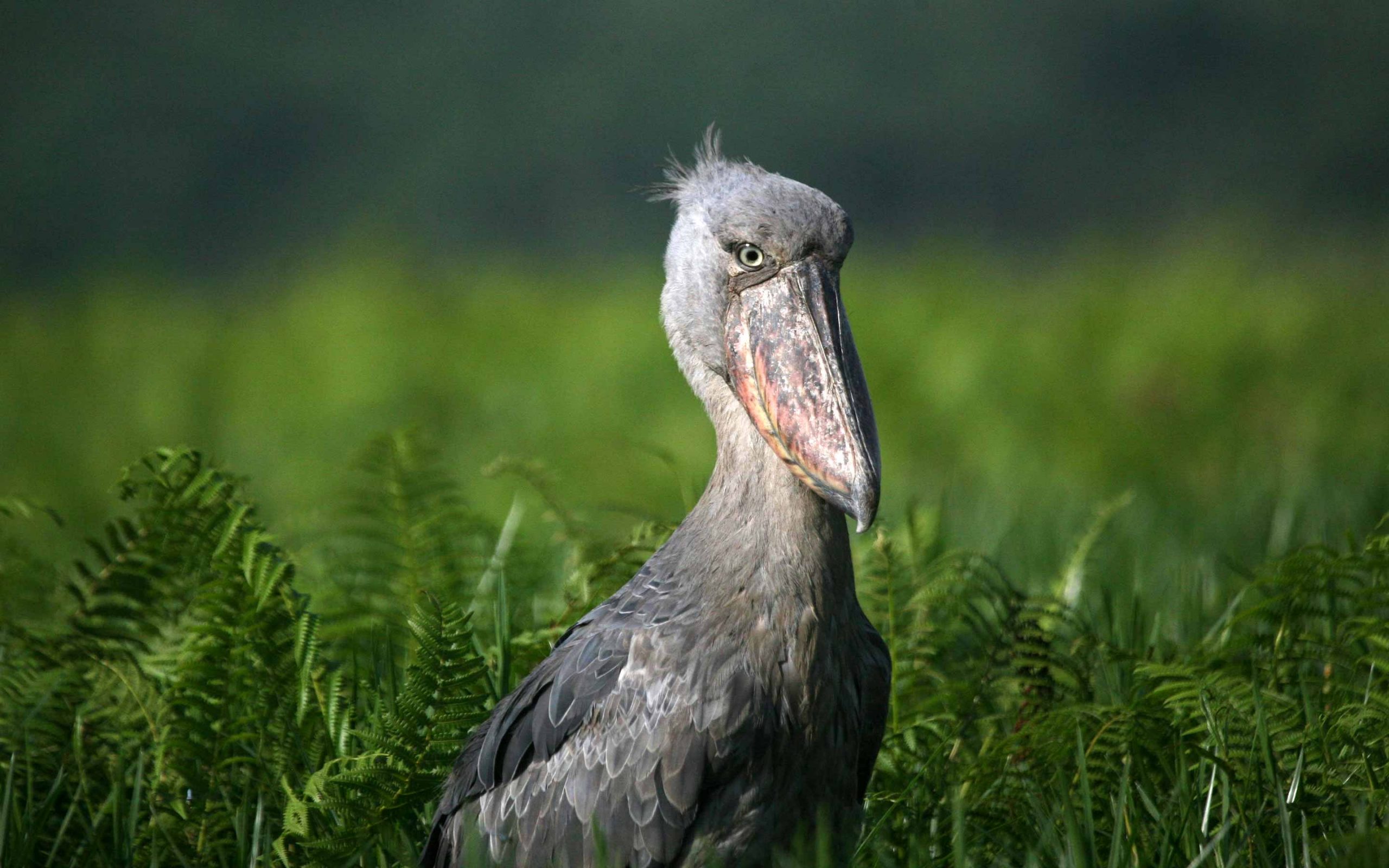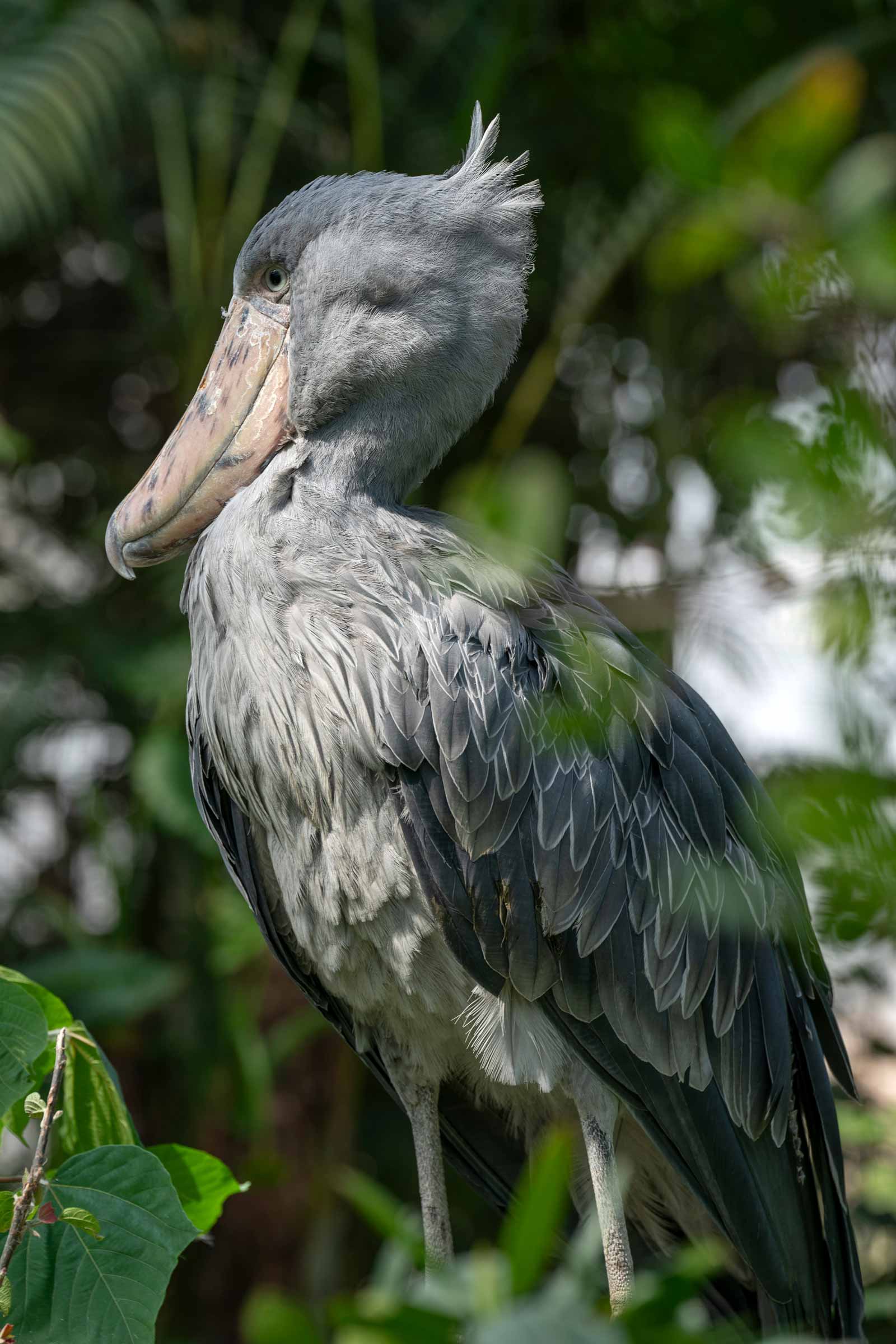Shoebill
The Shoebill is a unique, endangered African bird known for its distinctive bill and wetland habitat.

Overview
The Shoebill, also known as the Whale-headed Stork, is a large bird species endemic to the swamps and marshes of central tropical Africa. Renowned for its strikingly large bill that resembles a wooden shoe, this bird is a master of patience and precision in hunting. Despite its somewhat intimidating appearance, the Shoebill is a symbol of tranquility, often observed standing motionless for hours as it waits for prey. These fascinating birds have fascinated ornithologists and bird watchers alike due to their unique adaptations and behaviors, which offer insights into the complex ecosystems of African wetlands.
Scientific Classification
- Kingdom: Animalia
- Phylum: Chordata
- Class: Aves (Birds)
- Order: Pelecaniformes
- Family: Balaenicipitidae
- Genus: Balaeniceps
- Species: Balaeniceps rex
Description
The Shoebill is a tall and imposing bird, standing between 110 to 140 centimeters (43 to 55 inches) in height, with a wingspan that can reach up to 260 centimeters (8.5 feet). Its most defining feature is its massive, bulbous bill, which measures up to 24 centimeters (9.4 inches) long and 20 centimeters (7.9 inches) wide. The bill is pale grey with sharp edges and a hooked tip, perfectly adapted for capturing and crushing prey.
The Shoebill’s plumage is predominantly blue-grey, with darker feathers on the wings and tail. Its eyes are piercing yellow, giving it an intense, almost prehistoric look that can be startling at first glance. The legs are long and dark, well-suited for wading through the swampy waters of its habitat. Juveniles are distinguishable by their more brownish coloration and lack the adults’ distinctive bill pattern, slowly acquiring their full adult plumage and bill coloration as they mature.

Behaviour
The Shoebill is predominantly solitary, often found alone or in pairs, and it rarely forms flocks. It is a masterful hunter, primarily feeding on fish, particularly lungfish, catfish, and tilapia, but its diet also includes amphibians, reptiles, and occasionally small mammals.
The hunting techniques of the Shoebill are unique and efficient. It remains perfectly still in the water, blending seamlessly with its surroundings as it waits patiently for prey to come within striking distance. When the moment is right, the Shoebill strikes with remarkable speed and accuracy, using its powerful bill to capture and kill its prey. This method of hunting is known as the “collapsing lungfish” technique, where the bird lunges forward, scooping up water and prey with its open bill, then snapping it shut with a forceful blow. This strategy is particularly effective in the dense and murky waters of African swamps, where visibility is often limited.
Breeding behaviors of the Shoebill are equally fascinating. The bird typically nests in secluded areas within its swampy habitat, constructing large platforms of vegetation. Both parents are involved in incubating the eggs and feeding the chicks, demonstrating a high level of parental care. Shoebills lay one to three eggs, with the strongest chick often being the sole survivor due to competition for food.
Habitat
The Shoebill’s preferred habitat is freshwater swamps, marshes, and wetlands with dense vegetation, often dominated by papyrus and reed beds. These areas provide an abundant supply of fish and other aquatic prey, as well as tall grasses and water plants that offer excellent cover for nesting and hunting. The wetlands are typically characterized by slow-moving or stagnant waters, which create ideal conditions for the Shoebill’s prey to thrive.
These habitats are often remote and difficult to access, providing the Shoebill with a refuge from human disturbance. The presence of papyrus swamps is particularly significant, as these ecosystems support a rich biodiversity and play a crucial role in maintaining the delicate balance of the wetland environment. The Shoebill’s preference for such specific habitats makes it a vital indicator species, reflecting the health of its wetland ecosystems.
Prominent protected areas and national parks where Shoebills can be observed include Uganda’s Mabamba Bay Wetland, which is renowned for its Shoebill population, and Zambia’s Bangweulu Wetlands, a critical habitat for the conservation of this species. These areas are crucial for the preservation of the Shoebill and offer visitors a unique opportunity to observe these magnificent birds in their natural habitat.
The Shoebill’s range is relatively limited, confined to the central tropical regions of Africa. Key countries where Shoebills are found include:
Sudan: The vast Sudd wetlands.
The Sudd, one of the world’s largest wetlands, offers a perfect habitat for the Shoebill with its expansive, slow-moving waters and dense vegetation.
South Sudan: Along the White Nile.
The wetlands along the White Nile provide an essential habitat for the Shoebill, supporting a diverse array of aquatic life.
Uganda: Particularly in the Mabamba Swamp on the shores of Lake Victoria.
Mabamba Swamp is a renowned bird-watching site, famous for its resident Shoebill population and accessible by boat tours.
Rwanda: In the Akagera National Park.
Akagera National Park, with its varied wetland habitats, is a significant conservation area for Shoebills in Rwanda.
Democratic Republic of Congo: In the swamps of the Congo Basin.
The Congo Basin’s swamps are remote and vast, providing an ideal environment for the elusive Shoebill.
Zambia: In the Bangweulu Wetlands.
Bangweulu Wetlands are a critical habitat for the Shoebill, with conservation efforts focused on preserving this unique ecosystem.
Conservation
The Shoebill is classified as Vulnerable on the IUCN Red List of Threatened Species. The primary threats to its survival include habitat destruction due to agricultural expansion, drainage of wetlands, and disturbance from human activities such as fishing and hunting.
Facts
Interesting facts about The Shoebill (Balaeniceps rex).
The Shoebill’s scientific name is Balaeniceps rex.
It is called a Shoebill because its bill resembles a wooden shoe in shape, with a broad, rounded structure that is unique among birds.
Shoebills are found in central tropical Africa, primarily in swamps and wetlands of countries like Uganda, Sudan, and Zambia.
Their diet mainly consists of fish such as lungfish, catfish, and tilapia, but they also eat amphibians, reptiles, and small mammals.
Shoebills can stand between 110 to 140 centimeters tall and have a wingspan of up to 260 centimeters.
Shoebills typically lay one to three eggs in a nest made of vegetation, with both parents involved in incubating the eggs and caring for the young.
In the wild, Shoebills can live up to 35 years.
Yes, Shoebills are capable of flight, although they are more often seen standing or wading in water.
They have long legs for wading in water, a large bill for catching and crushing prey, and keen eyesight for spotting potential food.
The best time to observe Shoebills is during the dry season when water levels are lower, making it easier to spot them in their wetland habitats.
Other Animals
Explore fauna in Africa.






